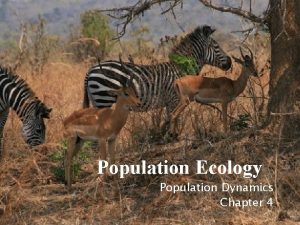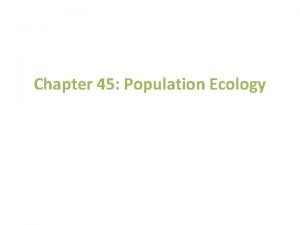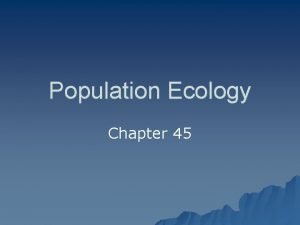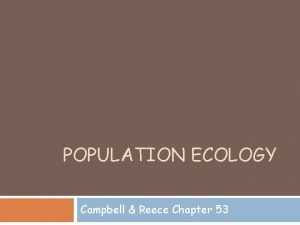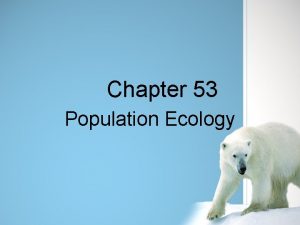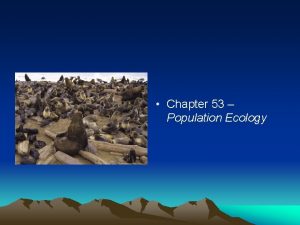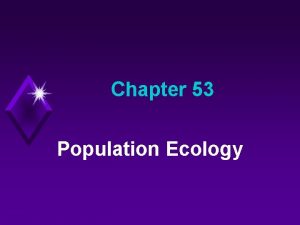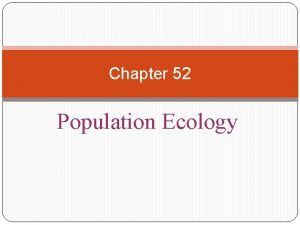Population Ecology Chapter 53 What is ecology Ecology














- Slides: 14

Population Ecology Chapter 53

What is ecology? Ecology is the study of organisms and their interactions with each other and their environment Abiotic Factors: light, water, nutrients, minerals, space etc. Biotic factors: mates, food, canopy cover, offspring etc. Population ecology studies how population numbers and locations change Recall that a population is a group of individuals of a single species in a specific area Ecologists define specific boundaries either natural or manmade Density measures how many individuals in a given area, for example how many trout in a square meter of lake Counting every organism can be daunting, so ecologists often take a sample Mark and Recapture (Fig. 53. 2) Quadrats https: //www. oceanmatters. org/wpcontent/uploads/2012/04/quadrats 1. jpg https: //d 1 e 4 pidl 3 fu 268. cloudfront. net/7 f 3 aeae 5 -00 f 1 -4189 -867434335 ff 02369/quadrat. crop_621 x 465_42, 0. preview. png

Populations are Dynamic Emigration and Immigration cause populations to be fluid Population density can help scientists to determine where the best habitats are Clumping shows individuals in patches Ex: Fungi Uniform shows individuals evenly spaced (can also show territory) Random shows no pattern in spacing Demography: The study of population statistics over time Life tables show individuals survive at each age Cohort: a group of the same age http: //nemaplex. ucdavis. edu/images/sampln 1. gif

Population Graphs Know these general curves and what they mean

Survivorship Curves https: //upload. wikimedia. org/wikipedia/commons/thumb/c/c 4/Survivorship_Curves. jpg/400 px-Survivorship_Curves. jpg Type I- provide care Type II- provide less care Type III- provide little to no care

https: //archive. cnx. org/resources/64522 a 7 f 22 df 9 f 70 dca 059 bff 0 d 746 c 9 e 40 be 33 f/Figure_45_03_01. jpg

Change in Population = Births+ Immigrants – Deaths - Emigrants N = population size t = time B = Births D = Deaths b = per capita birth rate m = per capita death rate r = per capita rate of increase r inst = instantaneous per capita rate of increase Exponential Growth Equation d. N/dt = rinst N J Shaped Curve http: //ccnmtl. columbia. edu/projects/biology/lecture 1/images/image 31. gif

Logistic Model Carrying Capacity: The maximum population size that a particular environment can sustain K Factors such as food, shelter, nutrients (abiotic and biotic factors) control K Logistic Growth Equation d. N/dt = r inst N ((K-N)/K) S Shaped Curve https: //slideplayer. com/slide/9815581/32/images/2/Environmental+Limits+on+Population+Growth. jpg

Life History Diversity Organisms vary a how often and at what age they reproduce Some organisms reproduce once “semelparity”, some reproduce multiple times “iteroparity” The variability depends on the offspring survival rate and the likelihood that the adult will reproduce again Unstable conditions lead to semelparity Stable conditions lead to iteroparity K selection: density dependent selection disease, resources, predation, territory, intrinsic factors, wastes R selection: reproductive success selection


Human Population

https: //ourworldindata. org/uploads/2013/05/updated-World-Population-Growth-1750 -2100. png

http: //www. algebralab. org/img/fba 2228 e-1 ba 1 -47 a 7 -b 6 a 2 -8 e 9399 ad 21 c 5. gif

https: //upload. wikimedia. org/wikipedia/commons/thumb/5/5 a/World_Map_-_Energy_Use_2013. png/440 px-World_Map_-_Energy_Use_2013. png
 Chapter 4 section 1 population dynamics study guide
Chapter 4 section 1 population dynamics study guide Chapter 4 section 1 population dynamics study guide
Chapter 4 section 1 population dynamics study guide Population ecology section 1 population dynamics answer key
Population ecology section 1 population dynamics answer key Population ecology section 1 population dynamics
Population ecology section 1 population dynamics Chapter 53 population ecology
Chapter 53 population ecology Chapter 36 population ecology
Chapter 36 population ecology Chapter 4 population ecology answer key
Chapter 4 population ecology answer key Chapter 53 population ecology
Chapter 53 population ecology Section 1 population dynamics answer key
Section 1 population dynamics answer key Chapter 53 population ecology
Chapter 53 population ecology Logistic growth ecology definition
Logistic growth ecology definition Logistic growth equation population ecology
Logistic growth equation population ecology Organismal ecology
Organismal ecology Ecosystem vs community
Ecosystem vs community Concept 3 population ecology
Concept 3 population ecology
















